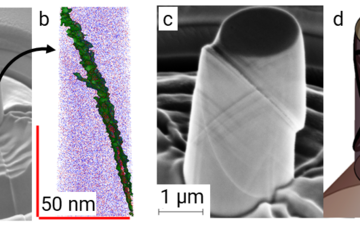All genres
321.
Talk
Examination of particle-surface contact under tribo-corrosion conditions with a novel low force micro indenter. 55th Meeting of the International Society of Electrochemistry, Thessaloniki, Greece (2004)
322.
Talk
On the corrosion resistance of a new class of FeCrAl light weight ferritic steels. 55th Meeting of the International Society of Electrochemistry, Thessaloniki, Greece (2004)
323.
Talk
Conducting polymer coatings for corrosion protection: Pros and cons. ISE Annual Meeting, Thessaloniki, Greece (2004)
324.
Talk
Corrosion under Cyclic Conditions Monitored by a Simultaneous Scanning Kelvin Probe and Galvanic Current Measurement. 55rd Meeting of the International Society of Electrochemistry, Thessaloniki, Greece (2004)
325.
Talk
Extended Abstract: Non-destructive, in-situ measurement of de-adhesion processes at buried adhesive/metal interfaces by means of a new scanning Kelvin probe blister Test. Euradh2004/Adhesion2004, Freiburg, Germany (2004)
326.
Talk
The role of the electrode potential at the buried polymer/metal interface on electrochemically driven delamination: The case MgZn2. ISE Annual Meeting, Thessaloniki, Greece (2004)
327.
Talk
Leitfähige Polymere für den Korrosionsschutz: Chancen and Risiken. DGO (GDCh) Jahrestagung, Graz, Austria (2004)
328.
Talk
Tailored semiconducting oxides for improved corrosion resistance and adhesion of organic coatings. Gordon Research Conference on Aqueous Corrosion, New London, NH, USA (2004)
329.
Talk
Applications of a new height regulated Scanning Kelvin Probe for the study of polymer/metal interfaces in corrosive environments. ICEPAM 2004, Helsinki, Finnland (2004)
330.
Talk
Detektion von Elementarprozessen der Tribokorrosion. Bunsen-Tagung 2004, Dresden, Germany (2004)
331.
Talk
The effect of Oxygen Reduction on the Self-Assembly and Stability of Thiol Monolayer Films. 205th Meeting of the ECS, San Antonio, TX, USA (2004)
332.
Talk
Galvanizing of Defined Model Samples: On the Road to a Fundamental Physical Understanding of Hot-Dip Galvanizing. GALVATECH, Chicago, USA (2004)
333.
Talk
Development of Zinc-Alloy Coatings with Inherent Delamination Stability for Organic Coatings. Galvatech '04, Chicago, IL, USA (2004)
334.
Talk
Delamination of Organic Coatings From Galvanized Steel: A Fundamental Overview. GALVATECH, Chicago, IL, USA (2004)
335.
Talk
From Novel Alloys to Tailored Surfaces. Meeting, University of Birmingham, Metallurgy and Materials Department, Birmingham, UK (2004)
336.
Talk
Moderne Schutzschichtsysteme auf der Basis molekularer Grenzflächenkonzepte. 25. Sitzung, Nordrhein-Westfälische Akademie der Wissenschaften, Düsseldorf, Germany (2004)
337.
Talk
Steel News: From Novel Alloys to Tailored Surfaces. Seminar, Fritz-Haber-Institut, Abteilung Physikalische Physik, Berlin, Germany (2004)
338.
Talk
Moderne Schutzschichtsysteme auf der Basis molekularer Grenzflächenkonzepte. 25. Sitzung, Nordrhein-Westfälische Akademie der Wissenschaften, Düsseldorf, Germany (2004)
339.
Talk
Non-destructive, real time in-situ measurement of de-adhesion processes at buried adhesive/metal interfaces by means of a new Scanning Kelvin Probe Blister Test. Annual Meeting of the American Adhesion Society, Wilmington, UK (2004)
340.
Talk
Korrelation zwischen Klimawechseltest und Freibewitterung. GFKORR Expertengespräch Organische Beschichtungen, Iserlohn, Germany (2004)











